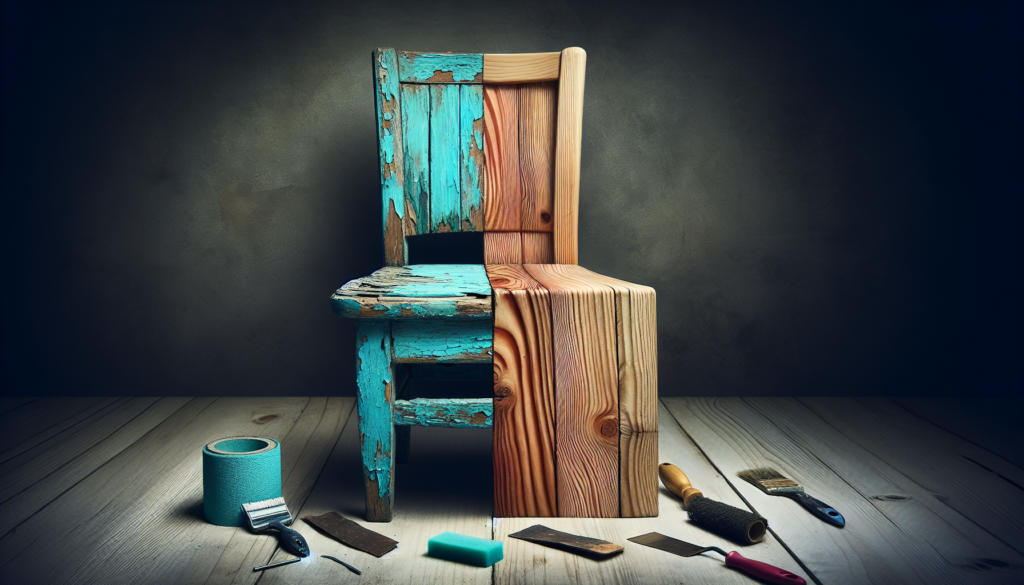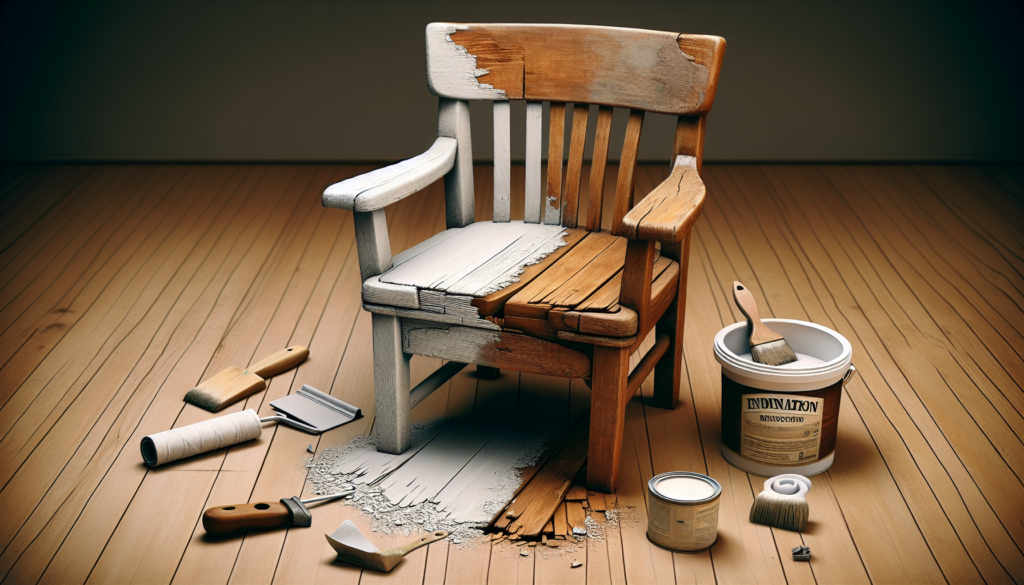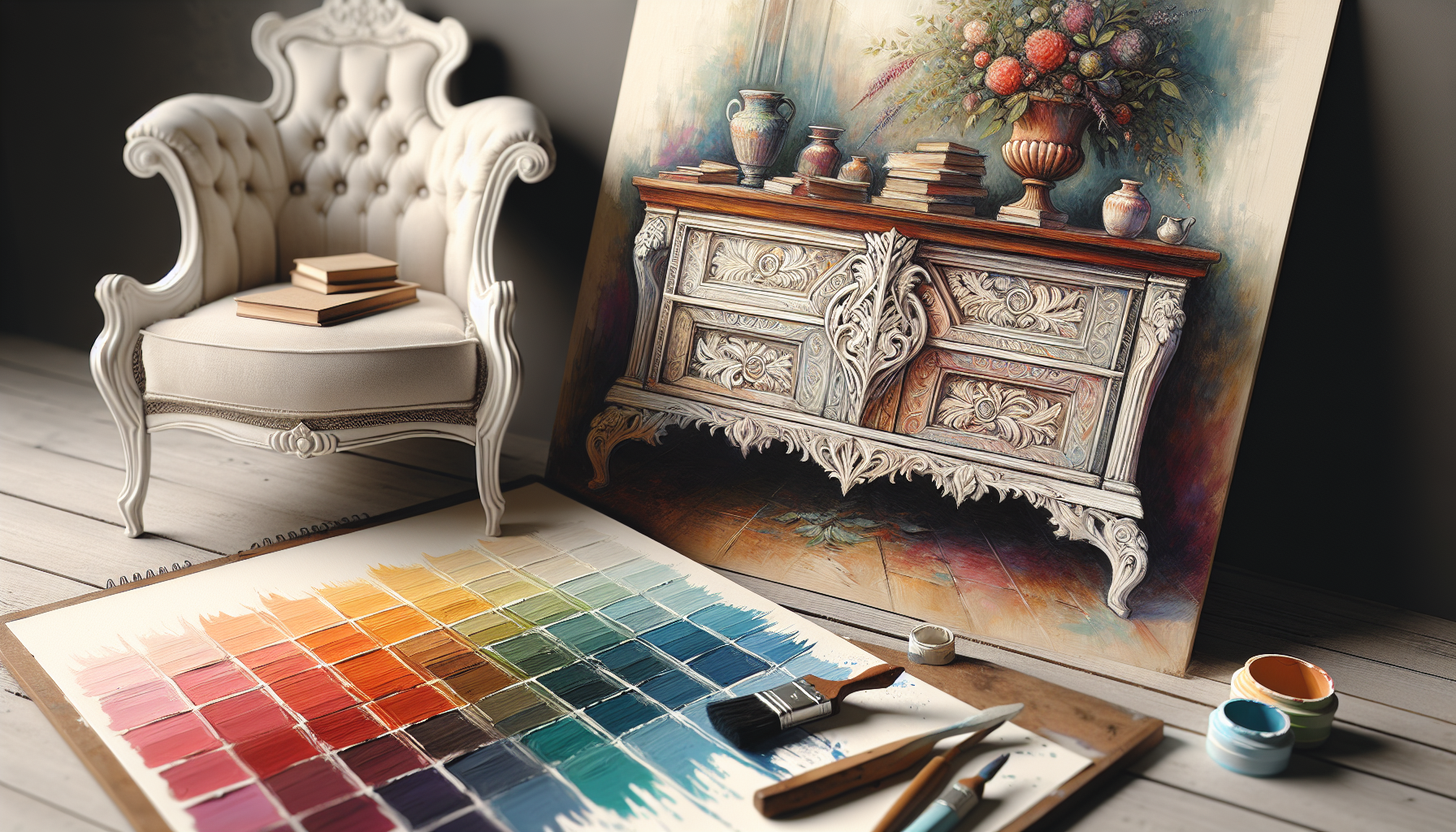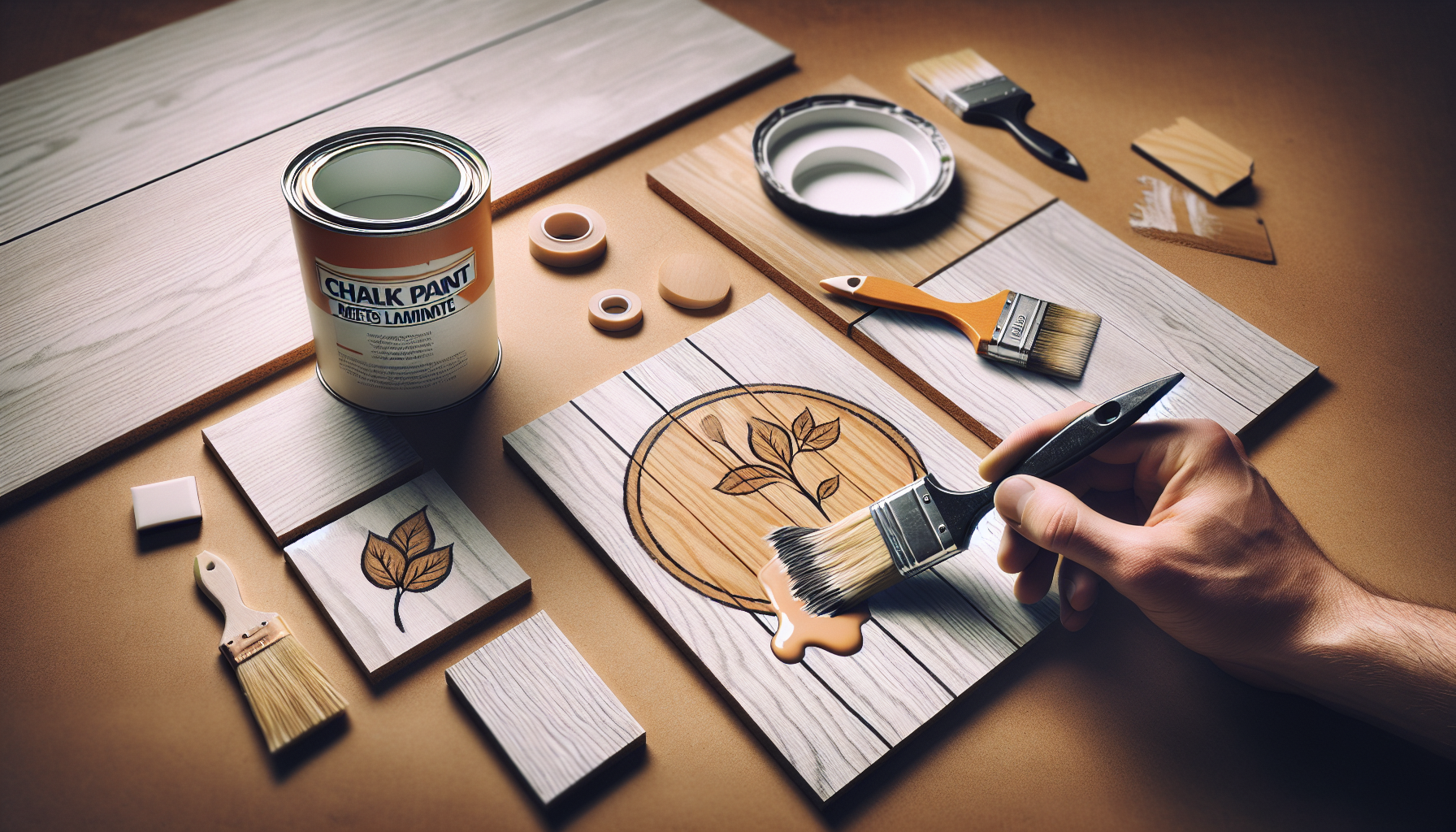Chalk paint has become a popular choice for giving furniture a chic and vintage look. However, when it comes to switching up your decor or restoring an old piece, removing chalk paint from furniture might seem like a daunting task. Fear not, as this article will guide you through the step-by-step process of effectively and efficiently removing chalk paint from your beloved furniture. Discover the techniques, tools, and precautions you need to take in order to achieve a pristine surface ready for your next creative endeavor.
Preparing the Area
Before you begin the process of removing chalk paint from furniture, it is important to properly prepare the area. This will ensure that the surrounding surfaces are protected and that you have all the necessary materials and equipment at hand.
Gathering the necessary materials
To remove chalk paint from furniture, you will need a few specific materials. These include:
- Chemical remover: Look for a product specifically designed for removing paint, such as a paint stripper or paint remover. Make sure to read the instructions and follow the safety precautions before using it.
- Heat gun or blow dryer: If you prefer using heat to remove the paint, a heat gun or blow dryer can be effective tools.
- Sandpaper: Depending on the type of surface you are working with, you may need sandpaper of various grits to remove the paint effectively.
- Vinegar: Vinegar can be a natural and effective solution for removing chalk paint. Make sure to use white vinegar for best results.
- Soap and water: A simple solution of soap and water can also be used to remove chalk paint from certain surfaces.
- Personal protective equipment: It is essential to wear gloves, safety glasses, and a mask while working with chemical removers or other potentially hazardous substances.
Make sure to gather all these materials before starting the paint removal process.
Protecting the surrounding area
Removing chalk paint can be a messy process, so it is crucial to protect the surrounding area from any potential damage. Cover the floor and any nearby furniture with drop cloths or plastic sheets to prevent paint drips or spills from causing stains or damage. Additionally, you may want to tape off or cover any areas that you do not want to be accidentally affected by the paint removal process.
Wearing personal protective equipment
To ensure your safety during the paint removal process, it is essential to wear personal protective equipment (PPE). This includes gloves, safety glasses, and a mask. Chemical removers can be caustic, so gloves will protect your hands from any potential skin irritation or chemical burns. Safety glasses will shield your eyes from any splashes or drips of the remover. Lastly, wearing a mask will prevent you from inhaling any harmful fumes or particles that may be released during the paint removal process.
By taking these preparatory steps, you are ready to start removing chalk paint from your furniture.
Testing a Small Area
Before proceeding with the entire surface, it is important to test the paint remover or other removal methods on a small, inconspicuous spot of the furniture. This will allow you to check for any potential negative reactions or damage that may occur with the chosen removal method.
Choosing an inconspicuous spot
Select a small area, such as the backside or underside of the furniture, where the removal will not be easily noticeable. By choosing an inconspicuous spot, you can test the paint remover without the risk of visibly damaging the furniture.
Applying a small amount of remover
Take a small amount of the chosen chemical remover and apply it to the selected test area using a brush or sponge. Follow the instructions on the product label regarding the application method and the amount of remover to use. Allow the remover to sit on the surface for the specified amount of time as mentioned in the instructions.
Checking for any negative reactions
After the recommended time has passed, examine the test area for any signs of negative reactions. Look for discoloration, bubbling, or any other unexpected changes in the surface. If there are any adverse reactions, discontinue the use of the particular remover and consider alternative methods. If there are no negative reactions, you can proceed with confidence to remove the chalk paint from the rest of the furniture.

Removing Chalk Paint with Chemical Remover
Chemical removers are a popular and effective choice for removing chalk paint from furniture. They work by breaking down the paint’s adhesion to the surface, making it easier to scrape off or wipe away.
Applying the chemical remover
Read the instructions on the chemical remover product carefully, as different products may require variations in application. Generally, you will need to apply a generous amount of the remover to the painted surface using a brush or sponge. Ensure that the entire painted area is covered with the remover, and be sure to work in small sections to prevent the remover from drying out before you have a chance to scrape off the paint.
Allowing the remover to work
Once the remover has been applied, it needs time to work on the paint. Check the instructions on the product label for the recommended waiting time. During this period, the chemical remover will begin to dissolve the chalk paint, making it easier to remove.
Scraping off the paint
After the recommended waiting time has passed, use a putty knife or a paint scraper to gently scrape off the dissolved paint. Start from one edge of the painted area and work your way across, applying firm but gentle pressure to avoid damaging the furniture’s surface. Be prepared to repeat this process in case there are any stubborn areas of paint that do not come off easily.
Removing any residue
Once you have removed the majority of the paint, use a clean cloth or sponge dampened with water to wipe away any remaining residue. Make sure to thoroughly clean the surface to remove all traces of the chemical remover. Allow the furniture to dry completely before proceeding with any further steps or recoating.
Removing Chalk Paint with Heat
Using heat to remove chalk paint can be an effective alternative method, especially for smaller surfaces or intricate areas where using chemical removers may be difficult.
Using a heat gun or blow dryer
To remove chalk paint with heat, you will need either a heat gun or a blow dryer. A heat gun is specifically designed for projects like these, but a blow dryer can work as well, although it may take longer to achieve the desired results.
Applying heat to the paint
Hold the heat gun or blow dryer a few inches away from the painted surface and begin applying heat. Move the tool back and forth slowly over the paint, making sure to heat the paint evenly. The heat will soften the paint, making it easier to scrape off.
Scraping off the softened paint
As the paint softens under the applied heat, use a putty knife or a paint scraper to gently scrape off the softened paint. Start from one edge of the painted area and work your way across, applying firm but controlled pressure. Repeat the process as necessary until all the paint has been removed.
Please note that when using heat as a removal method, it is important to exercise caution to avoid damaging the furniture or causing any accidents. Keep the heat gun or blow dryer at a safe distance from the surface and do not overheat the paint or the underlying material.

Removing Chalk Paint with Sandpaper
Another method to remove chalk paint from furniture is by using sandpaper. This method is particularly effective for surfaces that may not be suitable for chemical removers or heat treatments.
Choosing the appropriate grit
Select the appropriate grit of sandpaper depending on the texture and condition of the painted surface. A medium-grit sandpaper, such as 120 or 150, is a good starting point. If the paint is stubborn or if you are working with rougher surfaces, you may need to use a coarser grit initially and then switch to a finer grit as you progress.
Sanding the paint gently
With a firm but gentle grip, begin sanding the painted surface using the selected sandpaper. Move the sandpaper in a circular motion or in long strokes, working systematically across the painted area. The sandpaper will gradually remove the paint, revealing the underlying surface.
Keep in mind that sanding may take more time and effort compared to chemical removers or heat methods. Take breaks as needed to avoid strain and continue the sanding process until all the paint has been removed.
Wiping away the dust
As you sand, dust particles will be created. It is important to periodically wipe away the dust using a clean cloth or a vacuum cleaner with a brush attachment. This will ensure that you can see the progress and that the dust does not interfere with the sanding process. Repeat the sanding and dusting process until the desired results are achieved.
Removing Chalk Paint with Vinegar
Vinegar is a natural and eco-friendly option for removing chalk paint from furniture. It can be particularly useful for smaller areas or surfaces where other methods may not be suitable.
Creating a vinegar solution
In a container, mix equal parts white vinegar and water to create a vinegar solution. Make sure to use white vinegar as colored vinegars may stain the furniture. The acidic properties of vinegar help break down the chalk paint, making it easier to remove.
Applying the solution to the paint
Dampen a clean cloth or sponge with the vinegar solution and gently apply it to the painted surface. Make sure to cover the entire painted area. Allow the vinegar solution to sit on the paint for a few minutes to work its magic.
Scraping off the paint
Using a putty knife or a paint scraper, gently scrape off the softened paint. Start from one edge of the painted area and work your way across, applying firm but controlled pressure. If necessary, apply more vinegar solution to stubborn areas and repeat the scraping process until all the paint has been removed.
Cleaning the surface
After removing the chalk paint, dampen a clean cloth or sponge with water and wipe down the surface to remove any remaining vinegar solution or residue. This will ensure that the furniture is left clean and ready for any additional treatments or finishes.
Removing Chalk Paint with Soap and Water
Soap and water can be a simple yet effective method for removing chalk paint from certain surfaces. It is particularly suitable for sealed or semi-sealed finishes, such as varnished or lacquered furniture.
Creating a soapy water solution
In a container, mix a small amount of dish soap or mild detergent with water to create a soapy water solution. Ensure that the soap or detergent is gentle and does not contain any harsh chemicals that may damage the furniture’s finish.
Applying the solution to the paint
Dampen a sponge or cloth with the soapy water solution and gently apply it to the painted surface. Make sure to cover the entire painted area. Allow the soapy water solution to sit on the paint for a few minutes to loosen the chalk paint.
Using a sponge or cloth to scrub
Using the damp sponge or cloth, gently scrub the painted surface in a circular motion or in long strokes. Apply light pressure as needed to remove the paint, periodically rinsing the sponge or cloth and reapplying the soapy water solution. Repeat the scrubbing process until the paint has been removed.
Drying the surface
After removing the chalk paint, use a clean, dry cloth to wipe down the surface and remove any excess moisture. Allow the furniture to air dry completely before proceeding with any additional steps or finishes.
Removing Chalk Paint from Upholstery
If you accidentally get chalk paint on upholstered furniture, there are specific steps you can take to remove it without causing damage.
Dabbing the paint with a cloth
As soon as you notice the chalk paint on the upholstery, use a clean cloth or paper towel to gently dab at the paint. Do not rub or scrub, as this may spread the paint further or embed it into the fabric.
Blotting with a cleaning solution
If dabbing alone does not remove the paint, you may need to use a cleaning solution suitable for upholstery. Before applying any cleaning solution, test it on an inconspicuous area of the upholstery to ensure it does not cause discoloration or damage. Once you have determined its safety, dampen a clean cloth with the cleaning solution and gently blot at the paint.
Cleaning the upholstery
Continue blotting the affected area with the cleaning solution until the chalk paint has been fully removed. Once the paint is gone, use a clean cloth dampened with plain water to rinse the area. Blot the upholstery with a dry cloth or towel to remove excess moisture and allow the fabric to air dry completely.
It is important to note that some upholstery materials may require professional cleaning or specialized stain removal techniques. If you are uncertain or the paint stain persists, it is recommended to seek the assistance of a professional upholstery cleaner.
Rejuvenating the Furniture
Once the chalk paint has been successfully removed from your furniture, you may want to consider rejuvenating the piece by addressing any damage or applying a fresh coat of paint or finish.
Repairing any damage
Inspect the furniture for any scratches, dents, or other damage that may have occurred during the paint removal process. Depending on the severity of the damage, you may need to fill in gaps with wood filler, sand rough areas, or apply touch-up paint. Take the necessary steps to repair any damage before proceeding with the next steps.
Applying a fresh coat of paint or finish
If you have removed the chalk paint because you wish to change the color or restore the original finish of the furniture, now is the time to apply a fresh coat of paint or finish. Follow the appropriate instructions for the type of paint or finish you have chosen, ensuring that you apply it evenly and with proper coverage. Allow the paint or finish to dry completely before using or further treating the furniture.
Rejuvenating the furniture after removing the chalk paint will help restore its original beauty and prolong its lifespan.
Final Tips and Considerations
As you approach the process of removing chalk paint from furniture, it is important to keep the following tips and considerations in mind:
Taking safety precautions
Always prioritize your safety when working with chemical removers, heat tools, or other potentially hazardous materials. Wear the appropriate personal protective equipment, such as gloves, safety glasses, and a mask, to protect yourself from potential harm.
Seeking professional help if necessary
If you are unsure about the best approach or if your furniture requires specialized care, it is recommended to seek the assistance of a professional. They will have the knowledge and expertise to safely remove the chalk paint without causing damage to the furniture.
Considering alternative methods
While the methods outlined in this article are effective for removing chalk paint, there may be alternative approaches or products available that suit your specific needs. Research and consider different options before deciding on the best method for your furniture.
Using proper disposal methods
When disposing of any leftover chemicals, empty paint cans, or used sandpaper, make sure to follow the proper disposal methods as per your local regulations. Do not pour chemicals down drains or in regular trash bins, as they may pose a risk to the environment and human health. Consult your local waste management authorities for guidance on proper disposal methods.
By following these final tips and considerations, you can ensure a safe and successful process of removing chalk paint from your furniture. Remember to always prioritize safety, take your time, and enjoy the satisfaction of restoring your furniture to its former glory.



